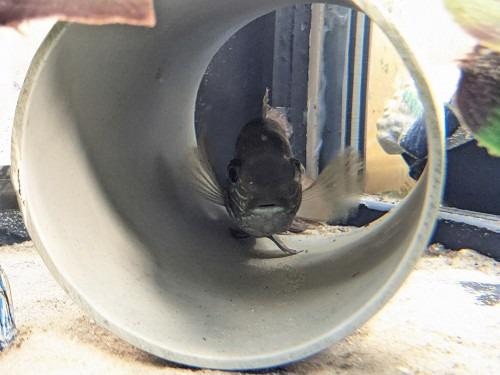Researchers at the University of Bristol have demonstrated how predators adapt their own behavior during a hunt to overcome their prey’s erratic behavior. The study, published in the scientific journal PNAS, calls into question the widely accepted belief that unpredictable behavior helps animals survive predator confrontations.
 A blue acara cichlid. Image Credit: Dr. Christos Ioannou
A blue acara cichlid. Image Credit: Dr. Christos Ioannou
Many prey species from all throughout the animal kingdom opt to run in a remarkable variety of directions rather than merely going directly away from predators. Scientists have long thought that their unpredictable behavior aids their evasion of capture by keeping predators puzzled about their next move.
Researchers from Bristol’s School of Biological Sciences were able to test this theory by analyzing how genuine predatory fish (blue acara cichlids) attack artificial prey. Rather than showing that unexpected escape methods benefit prey, a recent study reveals that predators can counteract this technique by modifying their own behavior in a flexible manner.
The robotic prey began each experiment motionless, like many actual species hiding from predators, until bolting once the cichlid predator came too close. Unlike genuine prey, their escape route could be designed ahead of time.
Over a series of interactions with the predators, the key design enabled researchers to modify how predictable the prey’s escape trajectory was.
Using robotic prey allowed us to present individual predators with one of two prey escape strategies: ‘predictable’ prey which repeatedly escaped in the same direction from one interaction with the predator to the next, or ‘unpredictable’ prey which escaped in random directions.
Dr. Andrew Szopa-Comley, Study Lead Author, University of Bristol
When faced with predictable prey, predators changed their approach speed according to the prey’s escape direction, traveling quicker when the prey was fleeing directly away from them and slower when the prey was escaping laterally.
This change occurred before the prey even began to flee, implying that the predators were able to predict the prey’s behavior based on past contacts. Predator individuals, on the other hand, did not modify their approach to match the prey’s escape angle when confronted with unexpected prey.
Interestingly, throughout the whole pursuit, predators faced with unpredictable prey seemed to perform just as well as those hunting predictable prey. Despite being deprived of reliable information on the prey’s likely escape direction, predators faced with unpredictable prey compensated by accelerating more in the later stages of the pursuit.
Our results suggest that the predators in our study were able to overcome the potential downsides of facing prey which behave unpredictably. From the prey’s point of view, this raises the question of whether unpredictable behavior is as widely beneficial as was originally though.
Dr. Christos Ioannou, Senior Author and Associate Professor, Behavioral Ecology, University of Bristol
These discoveries might have a big impact on how prey escape behavior evolves. They believe that the predator’s behavioral features, such as its ability to counter adapt, are important in deciding whether being unexpected is helpful to prey.
Dr. Szopa-Comley added, “One of the key messages from our research is that predators are capable of dynamically adjusting their behavior in a way that can have dramatic consequences for the success of prey survival strategies.”
Responsive robotic prey reveal how predators adapt to predictability in escape tactics
Image Credit: University of Bristol
Journal Reference:
Szopa-Comley, A. W, et al. (2022) Responsive robotic prey reveal how predators adapt to predictability in escape tactics. PNAS doi:10.1073/pnas.2117858119.